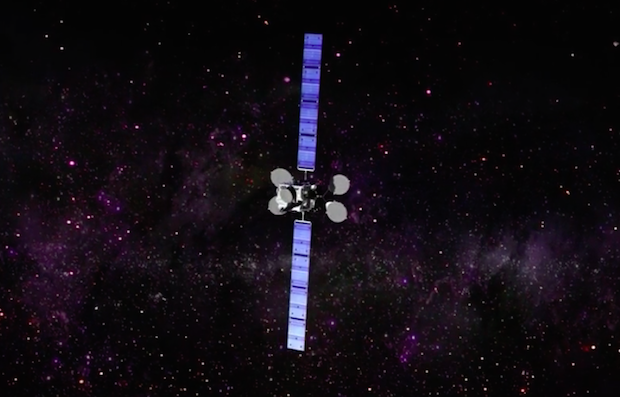
Investigators probing the sudden failure of the Boeing-built Intelsat 29e geostationary relay station in April have concluded an electrostatic discharge, aggravated by a harness flaw on the spacecraft, or a micrometeoroid strike prematurely ended the satellite’s mission, resulting in a $382 million hit to Intelsat’s quarterly financial report.
Intelsat said Tuesday that officials investigating the April 7 anomaly with Intelsat 29e have narrowed the cause of the failure to one of two possibilities.
“The failure review board concluded that the anomaly was either caused by a harness flaw in conjunction with an electrostatic discharge event related to solar weather activity, or the impact of a micrometeoroid,” Intelsat said in a discussion document released Tuesday in conjunction with the company’s second quarter financial numbers.
The board formed to investigate the Intelsat 29e failure included members from Boeing, which built the spacecraft, Intelsat and external independent experts.
Intelsat 29e was launched Jan. 27, 2016, aboard an Ariane 5 rocket from French Guiana for a planned 15-year mission. Based on the Boeing 702MP satellite design, Intelsat 29e was positioned in geostationary orbit at 50 degrees west longitude, where its thrusters kept the satellite parked over the same geographic region, with the spacecraft’s orbital velocity matching the rate of Earth’s rotation.
Intelsat has six other Boeing 702MP satellites in its fleet. After completing an assessment of potential crossover concerns, the company said there is a “very low risk of a similar event occurring on our other Boeing 702MP satellites.”
Since beginning commercial service three years ago, Intelsat 29e provided C-band video and data distribution services over South America, and beamed Ku-band signals across the Americas, including aeronautical routes over the North Atlantic, where passengers received live television and broadband Internet through the satellite.
Intelsat 29e was the first craft to launch in a new generation of Intelsat satellites known as the “Epic” series, which are capable of routing more data than earlier satellite models.
Richard Esposito, a Boeing spokesperson, said the company is “incorporating information gained from the investigation” into the Intelsat 29e failure to other spacecraft under construction at the Boeing satellite production line in El Segundo, California, “as a normal course of business.”
Esposito did not provide any details of potential changes to future Boeing-built communications satellites. The next satellite made by Boeing scheduled for launch is Amos 17, owned by the Israeli operator Spacecom Ltd. set for liftoff as soon as Saturday from Cape Canaveral atop a SpaceX Falcon 9 rocket.
Intelsat declared the Intelsat 29e satellite a total loss after losing contact with the spacecraft. Ground-based telescopes indicated the satellite suffered a fuel leak and shed debris as it drifted away from its operating slot in geostationary orbit more than 22,000 miles (nearly 36,000 kilometers) above the equator.
In Intelsat’s second quarter earnings report, the company recorded an “asset impairment charge” of $381.6 million to account for the failed satellite, which was not insured for a loss in space. Intelsat does not typically purchase third-party insurance for its satellites to cover an in-orbit failure after launch.
The failure of Intelsat 29e is also expected to reduce Intelsat’s revenues in 2019 by $45 million to $50 million, the company said.
Intelsat reported $509.4 million in earnings in April, May and June, with a net loss of $529.7 million during the same period. The company said the net loss reflects the $381.6 million asset impairment charge stemming from the Intelsat 29e failure.
Intelsat moved clients booked to use the Intelsat 29e spacecraft to other Intelsat satellites and networks from other companies to mitigate the failure, which affected maritime, aeronautical and wireless operator customers in the Latin America, Caribbean and North Atlantic regions.
“We immediately started developing plans for how we’re going to address the loss of … the capacity from this high-throughput satellite,” said Stephen Spengler, Intelsat’s CEO.
Intelsat commanded one of its more than 50 other operating satellites to begin drifting from a station over Africa to a new position over the Americas.
“That will be coming along, and we’re looking at other opportunities within our fleet to support back-filling some of that region’s capacity,” Spengler said Tuesday.
“We’re looking at other options across the industry, where we can potentially cooperate with other operators in bringing some near-term capacity into our operations for our customers,” Spengler said.
Intelsat is also assessing whether to “execute a quick procurement” of a new high-throughput satellite to replace Intelsat 29e, according to Spengler.
“We believe this is possible in a reasonable amount of time, that we can bring some differentiated high-throughput capacity into the network within a few years,” he said.
Large commercial communications satellites typically take two or three years to build and launch.
“Technology has progressed since the Intelsat Epic satellites were built, so we do think we can contract for a satellite that’s going to have even (more) improved economics in a cost-per-unit standpoint,” Spengler said. “So we will be able to take advantage of that.”
Another of Intelsat’s Boeing-built Intelsat Epic satellites, Intelsat 33e, suffered from a propulsion system anomaly after a successful launch on an Ariane 5 rocket in 2016. Intelsat 33e used backup thrusters to reach its final operating post in geostationary orbit, and investigators ruled out any connection between the Intelsat 29e failure and Intelsat 33e’s engine problem.
The next member of Intelsat’s fleet, Intelsat 39, is scheduled for liftoff Aug. 6 from French Guiana aboard an Ariane 5 rocket. Intelsat 39, which will launch in tandem with the European EDRS-C data relay satellite, will provide broadband networking, video and government services across Africa, Asia, Europe, the Middle East and the Indian Ocean region.
Intelsat 39 was manufactured by Maxar Technologies, formerly known as Space Systems/Loral.
Email the author.
Follow Stephen Clark on Twitter: @StephenClark1.



